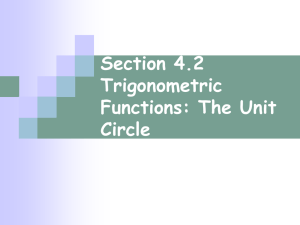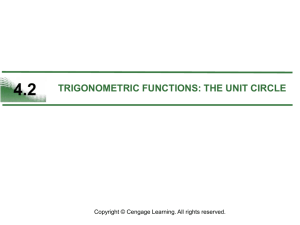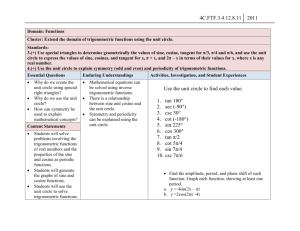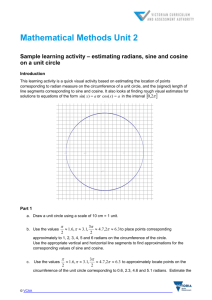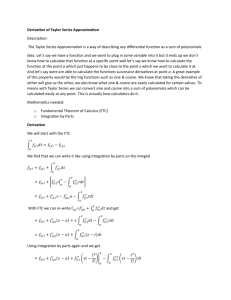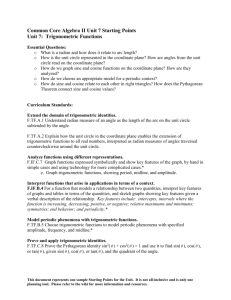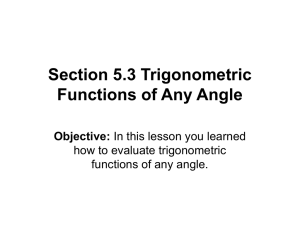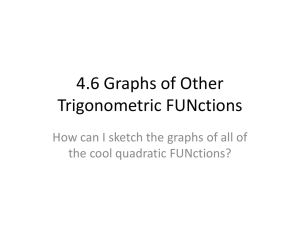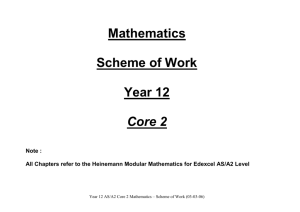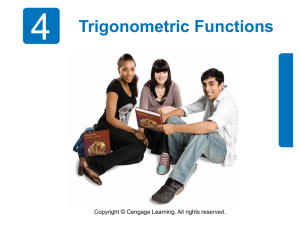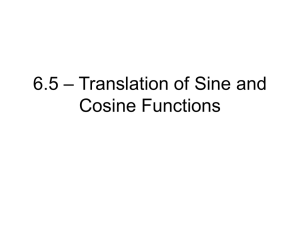01 HCPSS Algebra II Unit 7 Framework
advertisement
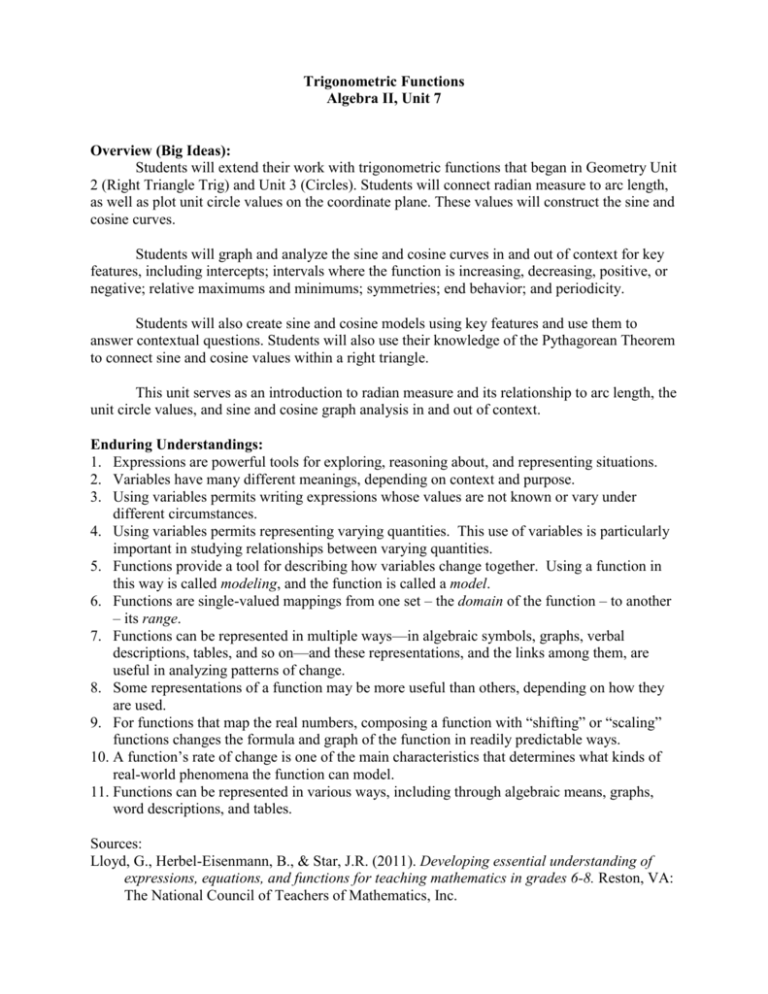
Trigonometric Functions Algebra II, Unit 7 Overview (Big Ideas): Students will extend their work with trigonometric functions that began in Geometry Unit 2 (Right Triangle Trig) and Unit 3 (Circles). Students will connect radian measure to arc length, as well as plot unit circle values on the coordinate plane. These values will construct the sine and cosine curves. Students will graph and analyze the sine and cosine curves in and out of context for key features, including intercepts; intervals where the function is increasing, decreasing, positive, or negative; relative maximums and minimums; symmetries; end behavior; and periodicity. Students will also create sine and cosine models using key features and use them to answer contextual questions. Students will also use their knowledge of the Pythagorean Theorem to connect sine and cosine values within a right triangle. This unit serves as an introduction to radian measure and its relationship to arc length, the unit circle values, and sine and cosine graph analysis in and out of context. Enduring Understandings: 1. Expressions are powerful tools for exploring, reasoning about, and representing situations. 2. Variables have many different meanings, depending on context and purpose. 3. Using variables permits writing expressions whose values are not known or vary under different circumstances. 4. Using variables permits representing varying quantities. This use of variables is particularly important in studying relationships between varying quantities. 5. Functions provide a tool for describing how variables change together. Using a function in this way is called modeling, and the function is called a model. 6. Functions are single-valued mappings from one set – the domain of the function – to another – its range. 7. Functions can be represented in multiple ways—in algebraic symbols, graphs, verbal descriptions, tables, and so on—and these representations, and the links among them, are useful in analyzing patterns of change. 8. Some representations of a function may be more useful than others, depending on how they are used. 9. For functions that map the real numbers, composing a function with “shifting” or “scaling” functions changes the formula and graph of the function in readily predictable ways. 10. A function’s rate of change is one of the main characteristics that determines what kinds of real-world phenomena the function can model. 11. Functions can be represented in various ways, including through algebraic means, graphs, word descriptions, and tables. Sources: Lloyd, G., Herbel-Eisenmann, B., & Star, J.R. (2011). Developing essential understanding of expressions, equations, and functions for teaching mathematics in grades 6-8. Reston, VA: The National Council of Teachers of Mathematics, Inc. Cooney, T., Beckmann, S., & Lloyd, G. (2010). Developing Essential Understanding of Functions Grades 9-12. Reston, VA: The National Council of Teachers of Mathematics, Inc. Essential Questions: o What is a radian and how does it relate to arc length? o How is the unit circle represented in the coordinate plane? How are angles from the unit circle read on the coordinate plane? o How do we graph sine and cosine functions on the coordinate plane? How are they analyzed? o How do we choose an appropriate model for a periodic context? o How do sine and cosine relate to each other in right triangles? How does the Pythagorean Theorem connect sine and cosine values? Common Misconceptions: o The calculator mode will change from Degrees to Radians for certain problems. Students need to pay attention to the context of each question. high low o When creating a sine or cosine model by hand, the amplitude is found by and 2 high low the vertical shift (midline) is , where high is the highest value and low is the 2 lowest value. These are often times easily confused. o Students need to use context to help set the window on their graphing calculator. Many times students think their calculator isn’t working, when all they need to do is adjust the range. window domain and o Students often confuse sin cos with sin 2 cos 2 . o Students need to pay close attention to the quadrant the angle is in, as this affects the positive/negative sign of the value. c o Students may need to factor y asin( bx c) d to y asin b(x ) d to more easily b identify the period and phase shift correctly. Content Standards: Extend the domain of trigonometric identities. F.TF.A.1 Understand radian measure of an angle as the length of the arc on the unit circle subtended by the angle. F.TF.A.2 Explain how the unit circle in the coordinate plane enables the extension of trigonometric functions to all real numbers, interpreted as radian measures of angles traversed counterclockwise around the unit circle. Analyze functions using different representations. F.IF.C.7 Graph functions expressed symbolically and show key features of the graph, by hand in simple cases and using technology for more complicated cases.* e. Graph trigonometric functions, showing period, midline, and amplitude. Interpret functions that arise in applications in terms of a context. F.IF.B.4 For a function that models a relationship between two quantities, interpret key features of graphs and tables in terms of the quantities, and sketch graphs showing key features given a verbal description of the relationship. Key features include: intercepts; intervals where the function is increasing, decreasing, positive, or negative; relative maximums and minimums; symmetries; end behavior; and periodicity.* Model periodic phenomena with trigonometric functions. F.TF.B.5 Choose trigonometric functions to model periodic phenomena with specified amplitude, frequency, and midline.* Prove and apply trigonometric identities. F.TF.C.8 Prove the Pythagorean identity sin2( ) + cos2( ) = 1 and use it to find sin( ), cos( ), or tan( ), given sin( ), cos( ), or tan( ), and the quadrant of the angle. Howard County Public Schools Office of Secondary Mathematics Curricular Projects has licensed this product under a Creative Commons Attribution-NonCommercial-NoDerivs 3.0 Unported License.
